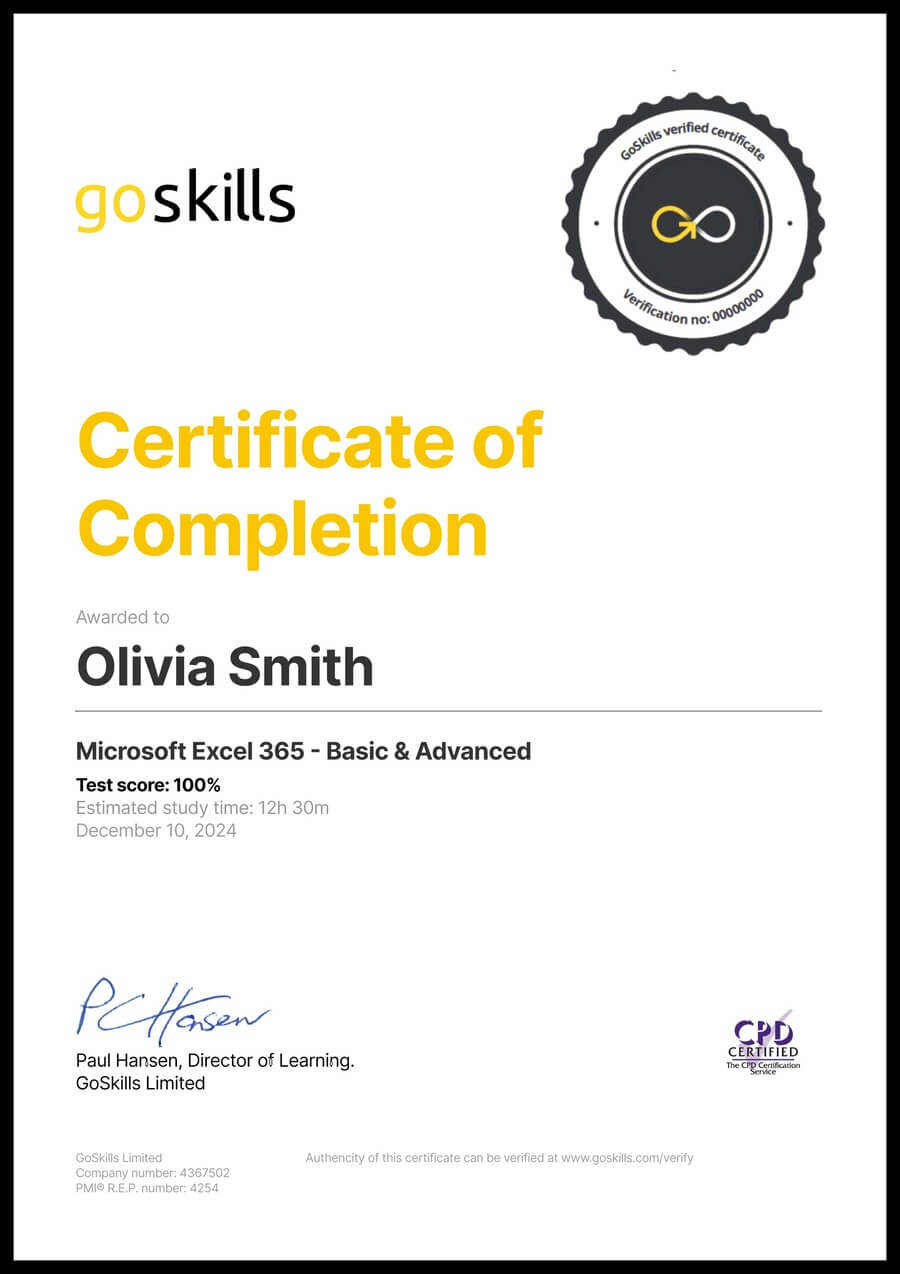Excel Financial Modeling Course | Online Training
Financial Modeling Techniques
Skills you’ll gain
Financial modeling in Excel is extremely useful to forecast and make key business decisions for your company. Learn this career-boosting skill in this Excel financial modeling course online, through proven methodologies and tools to help you construct a financial model step by step. The training covers financial statement theory and how they link together, building on the best practices and Excel functions covered in the Financial Modeling Basics course. Examples are provided throughout so that you can apply the practical knowledge you learn through hands-on application in Excel.
Highlights:
- 59 practical tutorials.
- Understand the different financial statement types and their key line items.
- Link the three financial statements together and add them to the model.
- Recognize the importance control accounts play in balancing the model.
- How to add the checks worksheet system to keep your model error-free.
- How to model revenue and working capital adjustments.
- Highlight the differences between the four different input methods.
- How to input COGS, OPEX and CAPEX into the financial statement.
- Calculate the control account for debt and interest payable.
- How to calculate tax components including tax expense, depreciation and losses.
- How to calculate Net Operating Cashflow using the Indirect Cashflow method.
Video tutorials are recorded in Microsoft Excel 2016 for PC. Learn more about how a GoSkills Excel certification can boost your career.
If you are a beginner and want to start with the basic concepts and functions of preparing a financial model, then check out the Financial Modeling Basics course first.
Want to be a more efficient Excel user? Start learning 200 of the best Excel shortcuts for PC and Mac.
Once enrolled, our friendly support team and tutors are here to help with any course related inquiries.
Syllabus
Download syllabus-
1
Financial Statement Types What are the Financial Statement Types, what do they tell us, and an overview of some of the line items in them. 5m
-
2
Income Statement What is the Income Statement, what does it tell us, and an overview of some of the line items in it. 5m
-
3
Balance Sheet What is the Balance Sheet, what does it tell us, and an overview of some of the line items in it. 5m
-
4
Cash Flow Statement What is the Cash Flow Statement, what does it tell us, and an overview of some of the line items in it. 7m
-
5
Three Way Integrated Financial Statements Link the three financial statements together and explain how it flows through. 3m
-
6
Control Accounts Explain the importance control accounts play in balancing the model when used effectively. When to create control accounts, how to create them and where to link their line items. 6m
-
7
Constructing Basic Financial Model How to construct the Financial Statements in basic financial modeling. 3m
-
8
Eating an Elephant How to construct a basic Financial Model by breaking it down into constituent parts. 8m
-
9
Importance of Checks Why are checks in models important and how to add the checks worksheet system. 3m
-
1
Exploring the Model Base An overview of what is required to build a Financial Model. 6m
-
2
Creating a Timing Sheet How to create a timing sheet to be used in building a Financial Model. 6m
-
3
Creating a Timing Sheet Part B A continuation of how to create a timing sheet to be used in building a Financial Model. 6m
-
1
The Income Statement How to add Financial Statements to the model in particular the Income Statement. 8m
-
2
Adding Financial Statements How to build the Financial Statements into the model. 6m
-
3
Checking Again Understand the different types of checks required when building a Financial Model and how to add them into the model. 7m
-
4
Checking Again Part 2 A continuation of understanding the different types of checks required when building a Financial Model and how to add them into the model. 5m
-
5
Linking the Financial Statements How are the Financial Statements linked? 8m
-
6
Linking the Financial Statements Part 2 A continuation on how the Financial Statements are linked. 5m
-
1
Revenue Introduction Explanation of what revenue is. 4m
-
2
Modeling Revenue Part 1 How to model revenue. 6m
-
3
Four Types of Inputs Define and highlight the differences between the four different input methods. 5m
-
4
Working Capital Adjustments Part 1 Understand Working Capital. 6m
-
5
Working Capital Adjustments Part 2 Understand Receivables as a part of Working Capital. 5m
-
6
Revenue Part 2 - Control Accounts Understanding Revenue with the use of Control Accounts. 5m
-
1
COGS Explanation of how to build COGS into the financial statement. 6m
-
2
COGS Part 2 A continuation of an explanation of how to build COGS into the financial statement. 3m
-
3
COGS Part 3 (Inventory) A continuation of an explanation of how to build COGS into the financial statement. 7m
-
4
COGS Part 4 (Inventory) A continuation of an explanation of how to build COGS into the financial statement. 6m
-
5
COGS Part 5 (Inventory) A continuation of an explanation of how to build COGS into the financial statement. 5m
-
6
COGS Part 6 (Inventory) A continuation of an explanation of how to build COGS into the financial statement. 5m
-
1
OPEX Part 1 Explanation of what should be considered as OPEX. 7m
-
2
OPEX Part 2 How to calculate OPEX using the Combination method. 5m
-
3
OPEX Part 3 How to calculate the OPEX Control Account and input into the Financial Statements. 6m
-
1
CAPEX Part 1 Explanation of what should be considered as CAPEX. 5m
-
2
CAPEX Part 2 How to calculate depreciation. 6m
-
3
CAPEX Part 3 How to calculate the CAPEX Control Account and input into the Financial Statements. 4m
-
1
Debt Part 1 Explanation of Debtors. 6m
-
2
Debt Part 2 How to calculate the Control Account for Debt and input into the Financial Statements. 5m
-
3
Debt Part 3 How to calculate the Control Account for Interest Payable and input into the Financial Statements. 5m
-
4
Interest Received Understand Interest Received. 4m
-
5
Interest Received Part 2 How to calculate Interest Receivable. 5m
-
6
Interest Received Part 3 How to calculate the Control Account for Interest Receivable and input into the Financial Statements. 3m
-
1
Tax Part 1 What is Tax? 5m
-
2
Tax Part 2 Understand the differences between Accounting and Tax treatments. 6m
-
3
Tax Part 3 What is a DTA and a DTL? 5m
-
4
Tax Part 4 How to calculate Tax Expense. 3m
-
5
Tax Part 5 How to calculate Tax Depreciation. 8m
-
6
Tax Part 6 How to calculate the DTLs. 5m
-
7
Tax Part 7 How to calculate Tax Payable and Tax Losses. 7m
-
8
Tax Part 8 How to calculate DTAs. 6m
-
9
Tax Part 9 How to calculate the Tax Control Account and input into the Financial Statements. 5m
-
1
Equity Part 1 Explaining the concept of Equity. 7m
-
2
Equity Part 2 How to calculate the Equity Control Account and input into the Financial Statements. 4m
-
3
Equity Part 3 How to calculate the Dividend Payable Control Account and input into the Financial Statements. 6m
-
1
Completing the Balance Sheet How to add the final touches to complete the Balance Sheet. 5m
-
1
Indirect Cash Flow How to calculate Net Operating Cashflow using the Indirect Cashflow method. 7m
-
2
Indirect Cash Flows Checks How to add Indirect Cashflow Statement checks. 6m
-
1
Summary A summary of what we covered in the Financial Modeling Techniques course. 3m
Certificate
Certificate of Completion
Awarded upon successful completion of the course.

Instructor
Liam Bastick
Liam is a Fellow of the Institute of Chartered Accountants (ICAEW), a Fellow of the Institute of Chartered Management Accountants (CIMA), a Chartered Global Management Accountant (CGMA) and is also a professional mathematician.
Liam has over 30 years’ experience in financial model development and auditing, valuations, M&A, strategy, training and consultancy. He has considerable experience in many different sectors including banking, energy, media, mining, oil and gas, private equity, transport and utilities. He has worked with many internationally recognised clients, constructing and reviewing strategic, operational and valuation models for many high profile IPOs, LBOs and strategic assignments. This has taken him to many countries including Australia, Belgium, Denmark, France, Germany, Hong Kong, Indonesia, Malaysia, Netherlands, New Zealand, Switzerland, the United Kingdom, the United States and Vietnam.

Liam Bastick
Excel MVP
Accreditations
Link to awardsHow GoSkills helped Chris
I got the promotion largely because of the skills I could develop, thanks to the GoSkills courses I took. I set aside at least 30 minutes daily to invest in myself and my professional growth. Seeing how much this has helped me become a more efficient employee is a big motivation.


